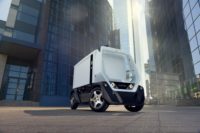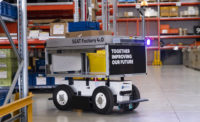In recent years, most efforts to develop autonomous vehicles have focused on last-mile delivery, driven by the rapid rise of e-commerce. The goal is to create machines that can deliver food and small packages directly to consumers in an affordable, quick, reliable and safe manner.
Fleets of autonomous delivery robots have been roaming around college campuses and other confined spaces. Now, the battery-powered vehicles are ready to hit the streets and sidewalks of urban areas beyond Silicon Valley and other warm weather locales, which is where many early tests were conducted.
Legislation that permits direct delivery devices to operate has been enacted in states ranging from Arizona to West Virginia. A variety of major cities have also recently passed ordinances, including Chicago, Detroit and Pittsburgh. It’s a way to reduce vehicular congestion and cut down on emissions.
Direct delivery devices, also known as personal delivery devices, are four- or six-wheeled vehicles that travel on sidewalks or streets and deliver food or small consumable products. Sensors enable them to assess obstacles and safely navigate around pedestrians, animals and large objects. The app-based robots are deployed by service providers that partner with local establishments to make deliveries within a small radius of restaurants, grocery stores and other retailers.
Competitive Market
Several start-up companies have jumped on the mobile delivery robot bandwagon, including Cartken, Clevon, Coco, Kiwibot, Nuro, Starship and Tortoise. Kiwibot has already deployed more than 500 delivery robots at 26 universities. Meanwhile, Tortoise has developed delivery devices that are being tested by Walmart Inc. Nuro has signed a 10-year deal with Uber Eats for robot food delivery.
Amazon Inc. conducted a three-year test in California with a vehicle called Scout, which is a six-wheeled device the size of a small cooler. However, the online retailer recently announced that it’s scaling back the project.
Direct delivery devices vary in size and shape. Some are similar to Scout, but others differ. For instance, Nuro's machines are close to the size of a small car. They also drive on public streets, not sidewalks. Its partnership with Uber may involve bundling multiple orders, as opposed to dispatching one at a time.
“These robots have the potential to transform the way that last-mile delivery is conducted,” says Ram Vasudevan, Ph.D., an associate professor of mechanical engineering and robotics at the University of Michigan. “Current last-mile solutions contribute to large amounts of pollution and add to congestion.
“By utilizing semi-autonomous, battery-powered robots that operate at the margin of the road and can get out of the way of traffic near the beginning and end of deliveries, these last-mile [systems] could significantly improve accessibility,” explains Vasudevan.
According to Vasudevan, companies are taking several different approaches to manufacturing their devices. For instance, Amazon produced Scout in-house on a manual indexing assembly line at its robotics facility in North Reading, MA.
Other companies are outsourcing subassemblies, such as bodies and chassis, and then installing electric motors, sensors and other important components in-house. Some firms outsource everything to contract manufacturers. For example, Kiwibot is building an average of 100 machines a month at a factory in Columbia.
Even Magna International Inc., a Tier One automotive supplier, has entered the mobile delivery robot business. It recently began assembling Cartken Inc.’s Model C at a factory in Michigan.
“Our ability to design, engineer and manufacture complete vehicles makes [us] an ideal partner for companies looking to solve last-mile delivery challenges with sustainable, autonomous and cost-effective solutions,” says Matteo Del Sorbo, executive vice president and head of Magna New Mobility.
Cartken's six-wheeled machines, which can operate indoors and outdoors, are equipped with a remote monitoring and teleoperation system that allows for instantaneous human override if necessary, which helps ensure safety and service. They are fitted with multiple cameras and lights, and respond to situations in real-time using a combination of machine learning and simultaneous localization and mapping (SLAM)-based navigation algorithms.
Who’s Who
A wide variety of direct delivery devices are being mass-produced. Several major players are jockeying for position, including giants such as FedEx Corp.
“Roxo” is the name of FedEx’s "SameDay Bot" that is designed for use in a three- to five-mile radius of any retailer’s location. Roxo is a rugged machine designed for autonomous last-mile delivery of small packages, such as pharmaceuticals. Other potential uses include delivering auto parts, general merchandise, pizza and groceries.
The mobile robot can climb curbs and steps to delivery packages directly to a customer’s door. Because Roxo is able to traverse the last 50 feet of a route, deliveries can be contactless and consumers with limited mobility can safely receive shipments.
Roxo was developed in collaboration with world-renowned inventor Dean Kamen, bringing together the technological expertise of DEKA Research & Development Corp. and the logistics and innovation expertise of FedEx. Roxo uses DEKA’s established iBot electric wheelchair base that is capable of negotiating rough terrain, steep inclines and unpaved surfaces.
FedEx views autonomous last-mile delivery as a new market for the company with “tremendous potential for growth.” Service features are still being developed, because it is one of the priciest and most complex parts of the delivery process.
Executives at FedEx are working with state and local officials on the testing and operation of new direct-delivery devices and related technologies. The goal is to make the service cost-effective, reliable and safe.
The current version of Roxo uses third-generation technology. Sensors maintain 360-degree awareness of all surroundings and artificial intelligence is used to choose the safest path or course of action.
Pedestrian-safe technology, multiple cameras and lidar enable the battery-powered robot to navigate a variety of terrain. These features are coupled with machine-learning algorithms to detect and avoid obstacles, plot a safe path and enable the machine to follow road safety rules.
With a tall profile, it is easy for pedestrians and motorists to see Roxo, which uses lights, signals and a message screen to communicate its directional intent.
Starship Technologies Inc. has developed small, cooler-sized robots that are designed to deliver food, groceries and packages locally in minutes. “The [machines] have traveled millions of miles and completed 3.5 million autonomous deliveries around the world,” claims Risto Meskus, head of manufacturing and supply chain at Starship.
“People call the robots cute, regularly pat them as they go past on the sidewalks, and increasingly tell us they feel like the robots are an integral part of the communities and neighborhoods they live in around the world,” says Meskus.
Sensors Make Sense
Inside each Starship robot is a suite of sensors, such as optical systems, point-cloud sensors, radar, inertial, ultrasonic sensors and processing units, which include CPUs, a GPU, neural network accelerators, field-programmable gate arrays and embedded integrated circuits.
According to Meskus, the industry as a whole is developing rapidly, and reserach on new sensors is progressing. Small size and flexibility will be key features for next-gen sensors.
Starship designs and manufactures its robots in-house. Manufacturing is colocated with R&D in Tallinn, Estonia.
“Parts are being sourced mainly from Europe and China, including electronic components and metal chassis,” explains Meskus. “Developing and manufacturing complex products with cutting-edge technology requires a lot of agility from the supply chain. Therefore, nearby final assembly with closely located partners provides strategic advantage in terms of speed when rolling out engineering changes.”
Currently, Starship produces approximately 80 percent of its assemblies in-house and manufacturing is relatively labor intensive. The process is divided into several phases, including body assembly, chassis assembly, final assembly and testing. Robots are manufactured by highly skilled operators, so possibilities for automation are limited.
During post-Covid supply chain disruptions, Meskus says the company’s purchasing and sourcing-related load increased 900 percent. However, Starship was able to take advantage of its vertical integration. Engineers have redesigned electronic subsystems to entirely different chip architectures, and validated and tested the designs. That effort has enable Starship to keep growth on track at a target of 300 percent, with minimal delivery disruptions and no system performance impact.
“Manufacturing and supply chains continue to evolve, especially as the company grows,” Meskus points out. “Engineers are currently transitioning a higher degree of subassembly value-added manufacturing to contract manufacturers. That’s allowing in-house teams to focus on complex high value-added work content and driving manufacturability improvements in product design work.
“[We are] actively working toward moving from building hundreds of units per month to thousands, as we scale our service across the world,” claims Meskus.
Nuro Inc. is another company pushing the envelope on autonomous mobile delivery robots. Its third-generation vehicle is about half as wide as a compact sedan. The four-wheeled machine is 6-feet tall, weighs 1,500 pounds and has a top speed of 45 mph. It’s equipped with state-of-the-art thermal cameras, lidar and radar, plus an external front air bag to protect pedestrians in case of collisions.
The R2 robot can carry a total of 500 pounds of cargo, with space for approximately 24 grocery bags in its storage compartments. Modular inserts allow for heating and cooling of the compartments. The vehicle can keep food at temps as low as -22 F or as hot as 116 F.
Nuro has formed strategic partnerships with companies such as 7-Eleven Inc., Domino’s Pizza Inc. and Kroger Co. The company also recently built a 100,000-square-foot assembly plant and test track in Las Vegas.
The new factory is “the industry’s first end-of-line manufacturing facility in America with the capacity to manufacture tens of thousands of delivery vehicles,” says Jiajun Zhu, CEO of Nuro.
In addition, the company is taking over 74 acres of the Las Vegas Motor Speedway to build what Zhu calls “a world-class, closed-course testing facility that will allow sophisticated development and validation of autonomous on-road vehicles.” The test track will enable Nuro engineers to measure vehicle performance in a broad range of scenarios, from avoiding pedestrians and pets to giving bicycles space on shared roadways.
Udelv Inc. recently unveiled an autonomous electric delivery vehicle for multi-stop delivery applications. The Transporter, powered by Mobileye technology, features a modular cargo pod called the uPod. It can carry up to 2,000 pounds of goods, make up to 80 stops per cycle at highway speeds, and cover ranges between 160 and 300 miles per run depending on the battery pack option.
“The Transporter is transformative for two of the world’s largest industries: automotive and logistics,” says Daniel Laury, CEO of Udelv. “It was created to solve two great challenges of commercial fleets: the shortage of drivers and the electrification of fleets."
Udelv's third-generation vehicle has already completed more than 20,000 deliveries for multiple merchants in Arizona, California and Texas. Udelv hopes to have 50,000 units operating on public roads by 2028, with the first Transporters being commercially deployed in 2023.
The vehicle has a top speed of 70 mph and can deliver a wide variety of products. Battery capacity is between 90 and 160 kilowatt hours, with a 160 to 300 mile range. DC fast-charging will take 45 minutes to add up to 220 miles of range.
"The Transporter will dramatically improve the efficiency and safety of last- and middle-mile delivery services,” claims Laury. “[It will] make deliveries affordable for everyone and everything from electronics and auto parts to groceries and medical supplies."








